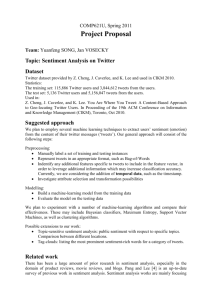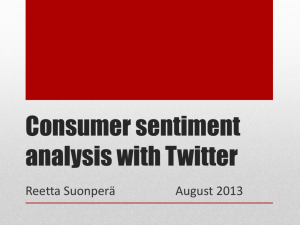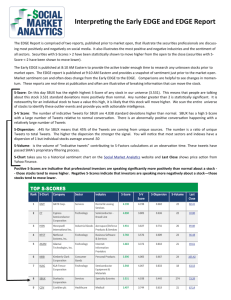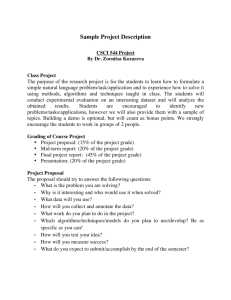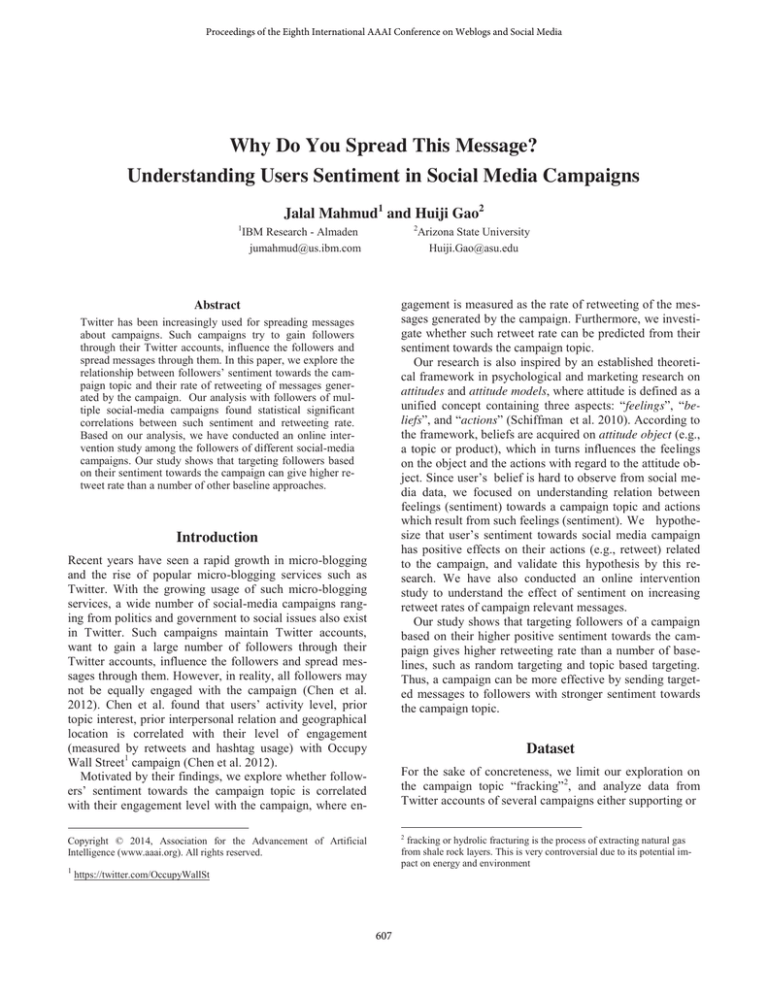
Proceedings of the Eighth International AAAI Conference on Weblogs and Social Media
Why Do You Spread This Message?
Understanding Users Sentiment in Social Media Campaigns
Jalal Mahmud1 and Huiji Gao2
1
2
IBM Research - Almaden
jumahmud@us.ibm.com
Arizona State University
Huiji.Gao@asu.edu
gagement is measured as the rate of retweeting of the messages generated by the campaign. Furthermore, we investigate whether such retweet rate can be predicted from their
sentiment towards the campaign topic.
Our research is also inspired by an established theoretical framework in psychological and marketing research on
attitudes and attitude models, where attitude is defined as a
unified concept containing three aspects: “feelings”, “beliefs”, and “actions” (Schiffman et al. 2010). According to
the framework, beliefs are acquired on attitude object (e.g.,
a topic or product), which in turns influences the feelings
on the object and the actions with regard to the attitude object. Since user’s belief is hard to observe from social media data, we focused on understanding relation between
feelings (sentiment) towards a campaign topic and actions
which result from such feelings (sentiment). We hypothesize that user’s sentiment towards social media campaign
has positive effects on their actions (e.g., retweet) related
to the campaign, and validate this hypothesis by this research. We have also conducted an online intervention
study to understand the effect of sentiment on increasing
retweet rates of campaign relevant messages.
Our study shows that targeting followers of a campaign
based on their higher positive sentiment towards the campaign gives higher retweeting rate than a number of baselines, such as random targeting and topic based targeting.
Thus, a campaign can be more effective by sending targeted messages to followers with stronger sentiment towards
the campaign topic.
Abstract
Twitter has been increasingly used for spreading messages
about campaigns. Such campaigns try to gain followers
through their Twitter accounts, influence the followers and
spread messages through them. In this paper, we explore the
relationship between followers’ sentiment towards the campaign topic and their rate of retweeting of messages generated by the campaign. Our analysis with followers of multiple social-media campaigns found statistical significant
correlations between such sentiment and retweeting rate.
Based on our analysis, we have conducted an online intervention study among the followers of different social-media
campaigns. Our study shows that targeting followers based
on their sentiment towards the campaign can give higher retweet rate than a number of other baseline approaches.
Introduction
Recent years have seen a rapid growth in micro-blogging
and the rise of popular micro-blogging services such as
Twitter. With the growing usage of such micro-blogging
services, a wide number of social-media campaigns ranging from politics and government to social issues also exist
in Twitter. Such campaigns maintain Twitter accounts,
want to gain a large number of followers through their
Twitter accounts, influence the followers and spread messages through them. However, in reality, all followers may
not be equally engaged with the campaign (Chen et al.
2012). Chen et al. found that users’ activity level, prior
topic interest, prior interpersonal relation and geographical
location is correlated with their level of engagement
(measured by retweets and hashtag usage) with Occupy
Wall Street1 campaign (Chen et al. 2012).
Motivated by their findings, we explore whether followers’ sentiment towards the campaign topic is correlated
with their engagement level with the campaign, where en-
Dataset
For the sake of concreteness, we limit our exploration on
the campaign topic “fracking” 2, and analyze data from
Twitter accounts of several campaigns either supporting or
2
fracking or hydrolic fracturing is the process of extracting natural gas
from shale rock layers. This is very controversial due to its potential impact on energy and environment
Copyright © 2014, Association for the Advancement of Artificial
Intelligence (www.aaai.org). All rights reserved.
1
https://twitter.com/OccupyWallSt
607
Twitter account
name of the campaign
Type
(pro/anti
fracking)
shalebiz
Energy From Shale
Fracking News
Frackfree America
pro
pro
anti
anti
# of followers as
of July 31,
2013
2776
3965
1219
1042
There were 5384 such users in total: 1562 users retweeted
pro-fracking tweets, and 3822 users retweeted antifracking tweets. We considered the users who retweeted
pro-fracking tweets as positive towards “fracking”, and
those who retweeted anti-fracking tweets as negative towards “fracking”. This is based on the traditional assumption that retweet is an act of endorsement of the original
tweet (Boyd et al. 2010). From the 5384 users (1562 positive, 3822 negative), we randomly sampled 1000 positive
(pro-fracking) users and another 1000 negative (antifracking) users. Then, we used Twitter’s REST API to
crawl the historical tweets (200 max.) of those users before
the retweet. Furthermore, we used Twitter's streaming API
to randomly sample another 1000 users who were assumed to have neutral sentiment towards “fracking”. We
also crawled their historical (200 max.) tweets. Thus, our
final dataset for sentiment prediction model contained
3000 users: 1000 positive, 1000 negative and 1000 neutral
towards “fracking”.
From this data, we constructed classification-based
model with three categories (positive, negative, neutral).
These are sentiment polarity for users' sentiment prediction. Our model used unigrams computed from historical
tweets as features. We tried a number of different statistical models from WEKA, a widely used machine learning
toolkit. SVM-based models outperformed others, and
achieved ~92% accuracy (0.92 recall, 0.93 precision, 0.925
F-measure) under 10-fold cross-validation.
# of Tweets
posted as of
July 31, 2013
6940
4826
3062
6133
Table 1. Social Media Campaigns in our dataset
Sentiment
Positive
Negative
Tweet
The science & economics of #fracking says yes to
fracking http://ow.ly/ll1J4
#Fracking wastewater threatens to drown Ohio:
http://t.co/ft768gkW
Table 2. Example tweets related to fracking
opposing “fracking”. We manually selected 4 Twitter campaigns related to “fracking” on July 31, 2013. Table 1
shows the data-statistics of the campaigns. We crawled
their tweets from last one month and identified tweets
which contained keywords or hashtags related to fracking,
such as “fracking”, “shale”, “#fracking”, “#shale”, “oil”.
We denoted these tweets as topic relevant tweets. We also
manually inspected those tweets and found that they were
indeed topically relevant. Table 2 shows few such tweets
with their sentiment. The rest of the tweets of each campaign in last one month are denoted as general tweets.
Then, we crawled followers of each campaign and their
tweets from last one month. These tweets are denoted as
recent tweets. However, we excluded followers who had
protected accounts or who had posted fewer than 100
tweets. We also crawled historical tweets (200 max.) of
those followers before last one month (tweets until July 1,
2013), and denoted such tweets as historical tweets.
Accuracy of Sentiment Prediction for Campaign
Followers
We conducted a study where participants labeled the sentiment (positive, negative, neutral) of the followers by
looking at their historical tweets (tweets until July 1,
2013). Then, we compared this manually labeled sentiment
with inferred sentiment by our algorithm and computed accuracy. We randomly selected 50 followers from each
campaign (200 followers in total) and collected their historical tweets. We recruited 100 participants from CrowdFlower (http://crowdflower.com/), a popular crowd sourcing platform. Each of them labeled 4 followers, and each of
the follower was labeled by two participants. Participants
were in agreement for 126 followers, and we used those as
ground-truth to compute the accuracy of our sentiment
prediction model. We applied our sentiment prediction
model to infer the sentiment of those 126 followers. Our
inferred sentiment matched manually labeled sentiment for
110 users which corresponds to 87.3% accuracy.
Sentiment and Retweet Behavior
Sentiment Prediction Model
Motivated by prior works on sentiment analysis (Barbosa
et al. 2010, Davidov et al. 2010), we developed a simple
content-based sentiment prediction model which predicts
the sentiment of a Twitter user towards “fracking”. We
first created a labeled dataset for sentiment prediction from
Twitter. We used Twitter’s streaming API from January,
2013 to March, 2013 for tweets containing keywords or
hashtags related to fracking (e.g., “fracking”, “shale”,
“#fracking”, “#shale”, “oil”). In total, we collected about
1.68 million tweets. We identified retweets from our data,
and computed how many times each tweet was retweeted.
We selected the tweets which were retweeted at least
100 times, and manually analyzed them for ground-truth
creation. In particular, we found 163 such tweets which we
labeled as either positive or negative towards “fracking”.
22 tweets were positive (pro-fracking tweets), and 141
tweets were negative (anti-fracking tweets). From our data,
we identified all users who had retweeted those tweets.
Correlation of Sentiment with Retweets
We applied the sentiment prediction model to infer the sentiment of followers of each campaign from their historical
tweets (tweets until July 1, 2013). Then, we investigated
whether followers' predicted sentiment towards fracking
has any correlation with their actions (e.g., retweets). Towards that, we analyzed the recent tweets of each follower,
608
Twitter account
name of the campaign
Shalebiz
Energy From Shale
to numeric scores. For followers of pro-fracking campaigns, the numeric scores are as follows: 1 for positive, 0
for neutral and -1 for negative. For followers of antifracking campaigns, we do the opposite (1 for negative, 0
for neutral and -1 for positive). Our sentiment prediction
model also returned a probability estimate associated with
sentiment prediction. We multiplied this probability with
the numeric score for predicted sentiment to obtain sentiment strength of each follower. Then, we also investigated
the correlation between sentiment strength and retweet
rates. As shown in Table 3, we found positive correlations between sentiment polarity, and retweet rates for all
campaigns. This indicates that followers who express similar sentiment of the campaign are also more likely to retweet messages generated by the campaign. For retweeting
topic relevant campaign tweets, such correlations are statistically significant for all campaigns. However, for retweeting general campaign tweets, correlations are not statistically significant. Table 3 also shows the correlations
between sentiment strength and retweeting rates. Statistical
significant correlations are observed in each case. We also
see a higher correlation value for sentiment strength, which
indicates its effectiveness to impact followers’ retweets.
Correlation Analysis
normalized-retweetnormalized-retweetrate-of-topic-relatedrate-of-generalcampaign-msg
campaign-msg
Corr.
Corr.
Corr.
Corr.
with
with
with
with
Sent.
Sent.
Sent.
Sent.
polarity
strength
polarity
strength
0.65*
0.7*
0.6
0.62*
0.71*
0.73*
0.64
0.65*
Fracking News
0.8*
0.82*
0.77
0.8*
Frackfree
America
0.6*
0.63*
0.5
0.55*
Table 3. Pearson correlation between sentiment and normalized retweet rates (* means significant, p < 0.05)
and computed the number of times they retweeted any topic relevant tweets of the campaign. We divided that number by the total number of topic relevant tweets of the
campaign. The resultant ratio is named as retweet-rate-oftopic-related-campaign-msg.
Twitter account
name of the campaign
shalebiz
Energy From Shale
Fracking News
Frackfree
America
Mean Absolute Error (MAE)
Predicting
Predicting
topical msg
general msg
Pred.
Pred.
Pred.
Pred.
from
from
from
from
Sent. poSent.
Sent.
Sent.
larity
strength
polarity
strength
0.32
0.30
0.28
0.27
0.25
0.24
0.25
0.23
0 35
0 32
0 33
03
Sentiment
Positive
Negative
0.26
0.28
0.27
0.25
Prediction Model
We also built predictive models of retweeting a campaign’s
message based on the sentiment of the followers. We performed both regression analysis and a classification study
using WEKA, a widely used machine learning toolkit. For
both cases, we tried two settings - predicting from sentiment polarity, and predicting from sentiment strength.
For regression analysis, sentiment polarity (first setting)
and sentiment strength (second setting) are used as the value of the independent variable in the regression model. Retweet rates are used as dependent variable in the model.
We tried a number of regression approaches (e.g., logistic
regression, SVM regression) and performed 10-fold cross
validation. Logistic regression performed the best, and the
results in terms of mean absolute error (MAE) are shown
in Table 4. We find lower prediction errors when predicting from sentiment strength. In particular, retweeting topical messages can be predicted within 23%-25% MAE and
general messages can be predicted within 25%-28% MAE.
For classification study, we used supervised binary machine learning algorithms to classify followers with above
median levels of retweet rates. We experimented with a
number of classifiers from WEKA, including naive Bayes,
We do a similar analysis for other tweets generated from
the campaign and computed the ratio: retweet-rate-ofgeneral-campaign-msg. Since some followers can be more
active in retweeing than others, we divided each of these
ratios by the total number of retweets of each follower over
last one month. This resulted normalized retweet rates
which we used for our analysis. Next, we conducted a
pearson correlation analysis between sentiment and retweet
rates. For such analysis, we converted predicted sentiment
shalebiz
Energy From Shale
Fracking News
Frackfree America
"To anyone speaking of the economic ”benefits” of
fracking: what use is that money if your food and water
are full of poison. Plz RT"(anti-fracking)
Table 6. Example intervention messages
Table 4. Regression results over 10 fold cross-validation
Twitter account
name of the campaign
Example Intervention Message
"@zas Plz RT “Fracking saves us money;; fracking
creates jobs"” (pro-fracking)
Area Under ROC Curve (AUC)
Predicting
Predicting
topical msg
general msg
Pred.
Pred.
Pred.
Pred.
from
from
from
from
Sent.
Sent.
Sent. poSent.
polarity
strength
larity
strength
0.67
0.74
0.63
0.70
0.69
0.76
0.67
0.72
0.70
0.77
0.66
0.73
0.73
0.80
0.70
0.74
Table 5. Classification results over 10 fold cross-validation
609
formed the other approaches. Our study shows that a campaign can be more effective by sending targeted messages
to followers with stronger sentiment towards the campaign.
Conclusion
In this paper, we investigated the relationship between sentiment of social media users who are following a campaign
and their likelihood of spreading campaign messages. We
found that sentiment has a statistically significant effect on
such activity. Furthermore, spreading topically relevant
campaign messages has stronger correlation with sentiment
of the campaign followers. Our engagement study provides
further insight for designing better intervention to spread
campaign messages. There are various directions for future
research. First, we like to apply similar analysis for other
types of actions such as hashtag usage, mentions or tweet
creation. Second, we will explore how other factors (e.g.,
general activity, prior interaction as suggested by Chen et
al. 2012) together with sentiment predict such actions.
Third, we will conduct a survey among campaign followers to understand their demographics, personality, network
size, etc. and analyze whether these factors affect their engagement with the campaign. Finally, we would like to investigate the generality of our findings by applying similar
analysis for social media campaigns on different topics.
Figure 1. Retweet rates for different target groups (500 messages were sent in each case)
SVM, J48, Random Forest. SVM slightly outperformed the
rest. Table 5 shows the classification result in terms of
AUC under 10-fold cross validation. We see that classifying high (above median) or low (below median) retweeters
from sentiment can be done quite accurately.
Online Engagement Study
We conducted an engagement study among followers with
different sentiment. In our study, we sent campaign relevant messages to such followers. We first created 6 accounts on Twitter, 3 for sending pro-fracking and another 3
for sending anti-fracking messages. We maintained a pool
of 10 pro-fracking messages and 10 anti-fracking messages. Each such message asked the recipient to retweet the
message.
We ranked the positive sentiment followers of profracking campaigns according to their sentiment strength
towards the “fracking” topic and selected top-500 (sentiment-ranked-top-followers) from the ranked list. From the
remaining pro-fracking followers, we randomly selected
500 followers and denoted them as followers. We obtained
another set of 500 users from random sampling from Twitter stream. Finally, we looked for Twitter stream for users
who mentioned the term “fracking” and obtained another
set of 500 users from such matched users (topic-relevant).
From our pro-fracking accounts, we sent pro-fracking
messages to each group of users. Thus, 500 messages were
sent for each target group. In each such message sending,
we randomly selected a message from the pool of 10 profracking messages. We waited about a week, and recorded
how many messages were retweeted in each case. Then,
we computed the retweet rates (defined as the ratio of the
number of messages retweeted and the total number of
messages sent) obtained in each case. We do a similar
study for anti-fracking followers. Thus, we sent antifracking messages to sentiment-ranked-top-followers of
anti-fracking campaigns. We also sent those messages to
randomly selected 500 followers of those campaigns, randomly selected 500 users from Twitter, and randomly selected 500 topic-relevant users from Twitter.
Figure 1 shows the retweet rates obtained in each case.
We observe that sentiment-ranked approach clearly outper-
Acknowledgement
Research was sponsored by the U.S. Defense Advanced
Research Projects Agency (DARPA) under the Social Media in Strategic Communication (SMISC) program,
Agreement Number W911NF-12-C-0028. The views and
conclusions contained in this document are those of the author(s) and should not be interpreted as representing the official policies, either expressed or implied, of the U.S. Defense Advanced Research Projects Agency or the U.S.
Government. The U.S. Government is authorized to reproduce and distribute reprints for Government purposes notwithstanding any copyright notation hereon.
References
Barbosa, L. and Feng, J. Robust sentiment detection on twitter
from biased and noisy data. In Proc. COLING, 2010.
Boyd, D. Golder, S., Lotan, G. 2010, Tweet, Tweet, Retweet:
Conversational Aspects of Retweeting on Twitter. In Proc.
HICSS 2010.
Chen, J. Pirolli, P. 2012. Why You Are More Engaged: Factors
Influencing Twitter Engagement. In Proc. ICWSM 2012.
Davidov, D., Tsur, O. and Rappoport, A. Enhanced sentiment
learning using twitter hashtags and smileys. In Proc. COLING
2010.
Schiffman, L.G. Kanuk, L.L. Wisenblit, J. Consumer Behavior.
10th edition. Prentice Hall - 2010.
610


